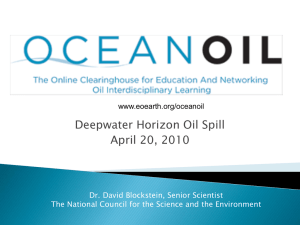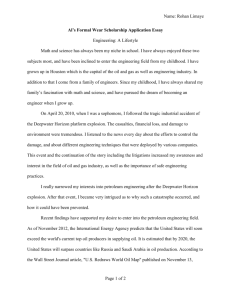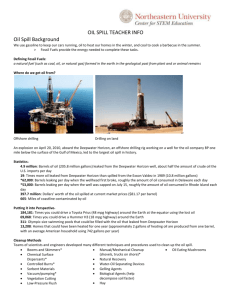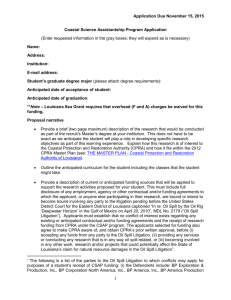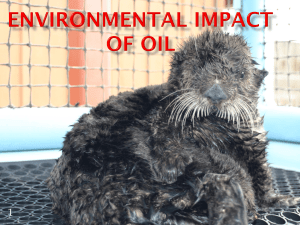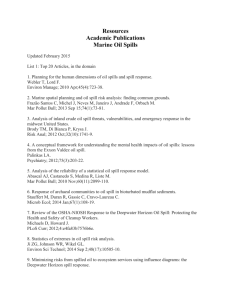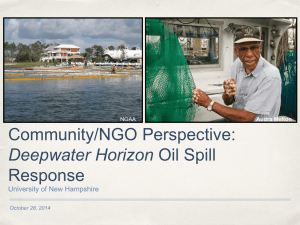Professor Weaver comments on a lawsuit filed against BP by... article on the Deepwater Horizon Case.
advertisement
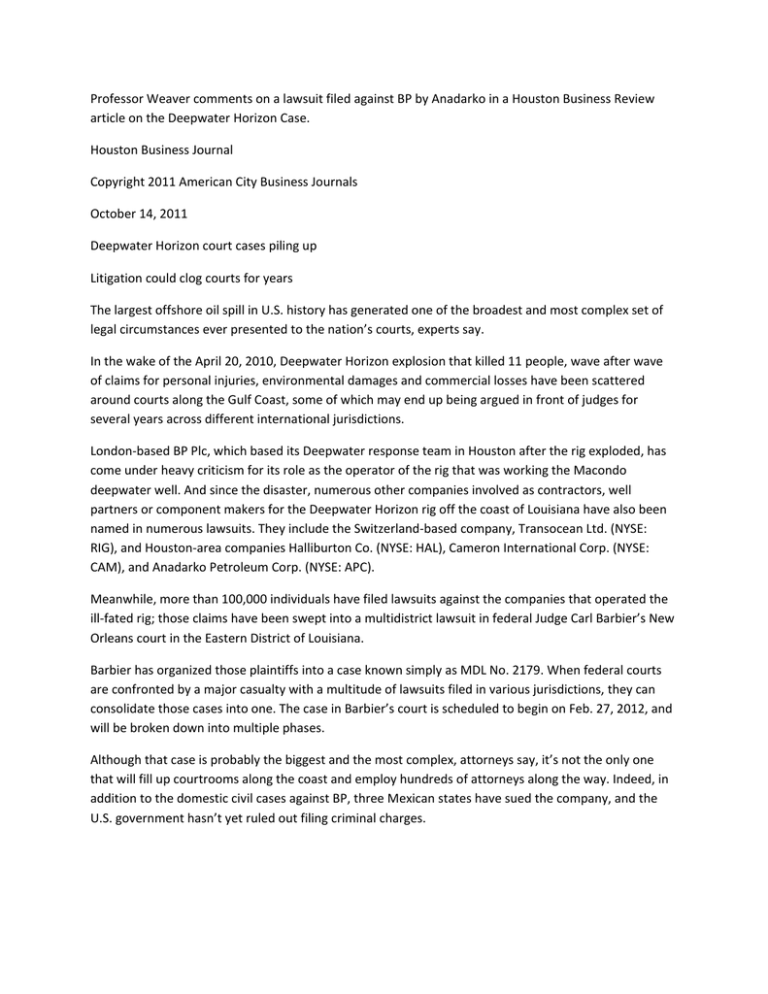
Professor Weaver comments on a lawsuit filed against BP by Anadarko in a Houston Business Review article on the Deepwater Horizon Case. Houston Business Journal Copyright 2011 American City Business Journals October 14, 2011 Deepwater Horizon court cases piling up Litigation could clog courts for years The largest offshore oil spill in U.S. history has generated one of the broadest and most complex set of legal circumstances ever presented to the nation’s courts, experts say. In the wake of the April 20, 2010, Deepwater Horizon explosion that killed 11 people, wave after wave of claims for personal injuries, environmental damages and commercial losses have been scattered around courts along the Gulf Coast, some of which may end up being argued in front of judges for several years across different international jurisdictions. London-based BP Plc, which based its Deepwater response team in Houston after the rig exploded, has come under heavy criticism for its role as the operator of the rig that was working the Macondo deepwater well. And since the disaster, numerous other companies involved as contractors, well partners or component makers for the Deepwater Horizon rig off the coast of Louisiana have also been named in numerous lawsuits. They include the Switzerland-based company, Transocean Ltd. (NYSE: RIG), and Houston-area companies Halliburton Co. (NYSE: HAL), Cameron International Corp. (NYSE: CAM), and Anadarko Petroleum Corp. (NYSE: APC). Meanwhile, more than 100,000 individuals have filed lawsuits against the companies that operated the ill-fated rig; those claims have been swept into a multidistrict lawsuit in federal Judge Carl Barbier’s New Orleans court in the Eastern District of Louisiana. Barbier has organized those plaintiffs into a case known simply as MDL No. 2179. When federal courts are confronted by a major casualty with a multitude of lawsuits filed in various jurisdictions, they can consolidate those cases into one. The case in Barbier’s court is scheduled to begin on Feb. 27, 2012, and will be broken down into multiple phases. Although that case is probably the biggest and the most complex, attorneys say, it’s not the only one that will fill up courtrooms along the coast and employ hundreds of attorneys along the way. Indeed, in addition to the domestic civil cases against BP, three Mexican states have sued the company, and the U.S. government hasn’t yet ruled out filing criminal charges. Charles F. Herd Jr., a maritime attorney for more than 20 years at The Lanier Law Firm PC in Houston, said the Deepwater Horizon case in total represents a panoply of different parts of the law, some of which appear to be in conflict with each other. For example, there is ongoing debate as to whether federal statutes, known as Maritime Common Law, apply to fallout from the explosion or if the laws of adjoining states would be most applicable. Once the courts determine which body of law controls the outcome, there may be gaps that would have to be remedied by another set of laws, Herd said. “The ‘joke’ is this is a lawyer’s nightmare, but a law professor’s dream,” he said. “Lawyers and scientists will be wrestling with some of these issues for many, many years — some of them for the rest of their careers — and that’s before we even talk about the human tragedy, which is enormous by any calculation.” A panel of federal judges met last fall to consider which cases belonged in the multi-district suit and where the case should be heard. That body determined New Orleans would be the most appropriate venue because it’s the largest city closest to scene of the incident. Many of the individual cases originated from that region and the New Orleans court has the staff to handle the scope and scale of the complex litigation. The trial will be conducted in at least three phases, a process Herd describes as organized such that it will move “like a pygmy through a python because it’s so enormous.” The first phase of the trial — the “incident phase” — will address the conduct of those present during the fire, explosion and initial release of oil from the Macondo well. The second phase — “source control” — will address the amount of oil released into the Gulf. The third phase — “containment” — will address the controlled burning and use of dispersants to cleanup the spill. University of Houston School of Law professor Jacqueline Lang Weaver said one of the most interesting elements of the case from an oil and gas industry standpoint is a lawsuit filed by Anadarko against BP in April of this year, seeking compensation for economic losses. Anadarko also asked the court to dismiss the company from any responsibility for damages. Anadarko owned 25 percent of the Macondo well and under its joint operating agreement with BP, it must pay 25 percent of any damages. However, also stipulated in that agreement is language stating that if BP is found to be “grossly negligent,” then Anadarko is not liable for any damages. “In many ways, this case may set more of a precedent than what may happen in the multidistrict lawsuit,” said Weaver, who teaches oil and gas law. Weaver said some of the litigation arising from the Deepwater Horizon explosion will likely be in the courts for at least three years. The Exxon Valdez oil spill case took 20 years for its final appeals to conclude at the U.S. Supreme Court, and as a result, the country’s Oil Pollution Act was crafted. April 20, 2010 — Deepwater Horizon explodes in the Gulf of Mexico. May 4, 2010 — Third wrongful death suit filed in state court in Galveston County on behalf of the family of Aaron Dale Burkeen, one of 11 men missing after the explosion. Named as defendants were Transocean and BP, among others. July 24, 2010 — BP says an internal investigation has cleared it of gross negligence in the spill. July 27, 2010 — BP board announces Robert Dudley will replace Tony Hayward as CEO effective Oct. 1. Sept. 29, 2010 – Andy Inglis, who headed BP’s deepwater drilling operations in the Gulf of Mexico at the time of the spill, steps down as head of the upstream business. Dec. 15, 2010 — U.S. Justice Department sues BP, Anadarko and Transocean in the U.S. District Court for the Eastern District of Louisiana, alleging the companies’ negligent behavior and poor safety standards led to the explosion of the Deepwater Horizon and resulting oil spill. The suit asks for the court to waive the $75 million cap the Oil Pollution Act imposes on oil-spill-related offenses, asking that BP and the others be held liable without limit. Jan. 13, 2011 — First settlement in a wrongful death case reached for an undisclosed sum. The order was filed by Tracey Kleppinger on behalf of Karl Kleppinger, who died when the Deepwater Horizon oil rig exploded. April 19, 2011 — Halliburton sues BP in Texas state court accusing it of failing to accept responsibility for the disaster, as called for in its contract. April 20, 2011 — On the deadline for companies connected to the spill to file claims against each other, BP sues Transocean, Halliburton and Cameron International in U.S. District Court in New Orleans, seeking up to the full cost of the disaster — estimated at $42 billion — plus costs, interest and punitive damages from each of the companies that helped it drill the doomed well. April 20, 2011 — Anadarko Petroleum and Japan’s Mitsui sue BP challenging its demands that they contribute to the cost of the clean-up. Sept. 1, 2011 — Halliburton files a lawsuit against BP in Texas state court claiming negligent misrepresentation, business disparagement and defamation. Sept. 14, 2011 — Final federal report on the incident is released by the U.S. government, spreading the blame among BP, Transocean and Halliburton Co. Sept. 16, 2011 — U.S. District Judge Keith Ellison in Houston agrees with BP that the claims should be filed in U.K. courts because the company is based in London. Feb. 27, 2012 — Trial date in federal court in New Orleans in which U.S. District Judge Carl Barbier will decide which companies share the blame for the Gulf of Mexico oil spill and will have to pay for it in a nonjury trial, the first in a three-part trial. The second trial phase will gauge companies’ liability for actions and decisions during the months it took to stop the subsea gusher. This phase will also determine how much oil and gas was spilled into the Gulf, a figure the U.S. will use to calculate any civil or criminal fines. The third phase of the trial is for remaining liability issues, including claims related to efforts to contain and clean up the spill. The judge will also determine which parties, if any, bear responsibility for property damage and injuries allegedly caused by a chemical dispersant used to break up the spill.
